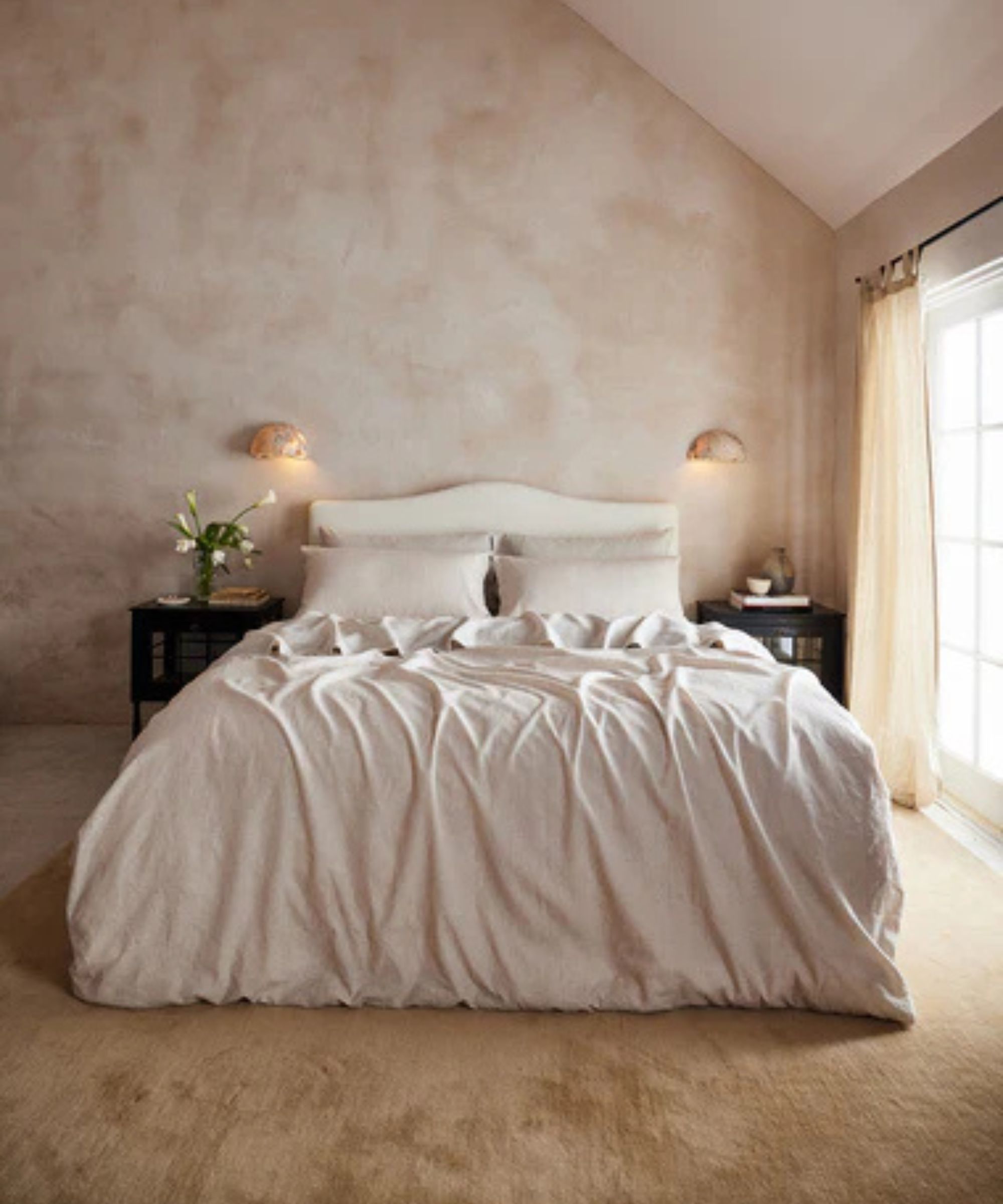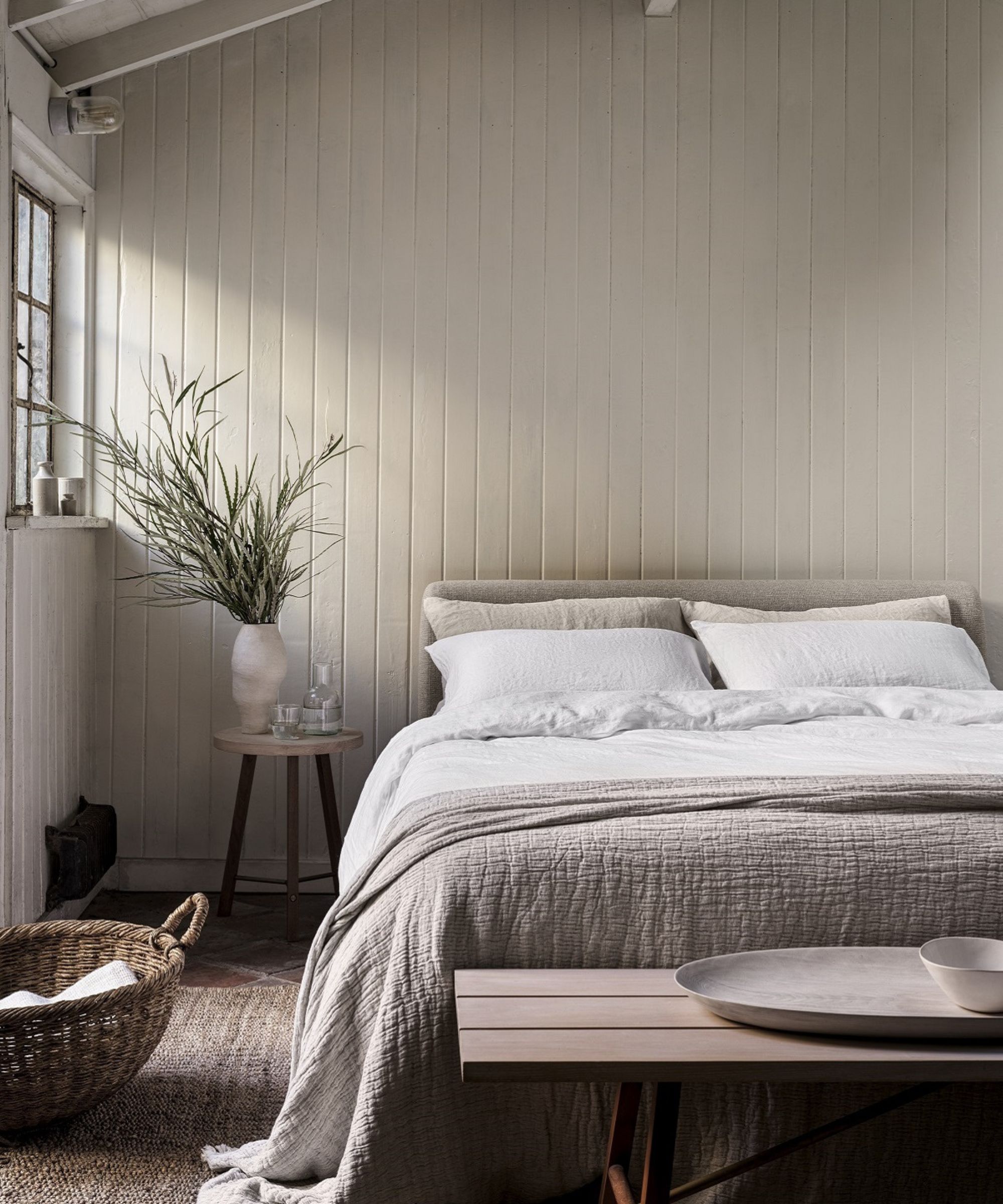What color bedding will make your bedroom look bigger? A sleep editor investigates
If you want your bedroom to look and feel luxurious, I suggest you steer clear of bold hues and dark tones in favor of this classic color palette


You wouldn't think it, but the color of your bedding can make a big difference to the look and feel of your bedroom. Dark, moody tones of gray, brown, or navy might complement your color palette, but they'll draw the eye down to the bed and make your space seem smaller.
Brighter, bolder shades of red, yellow, and orange might bring the sunshine into your bedroom, but again, they draw attention to the bed in a way that overpowers smaller spaces. There must be a middle ground.
I asked an expert panel of interior designers how to make a small bedroom look bigger. The general consensus is that decorating with neutrals is the best way to magnify your space, and buying a neutral bedding bundle is an easy, affordable fix.
What color bedding will make your bedroom look bigger?
Easy to pair and effortless to maintain, neutral bedding is a classic for a reason. I've asked my expert panel to reveal which neutral shades work best in the bedroom and explain a little more about the psychology behind the timeless trend. Along the way, I've picked out a few of the best bed sheets in neutral shades to save you time and money.

‘You can never go wrong with warm neutral colors for your bedding if you’re trying to make the room look as big as possible,’ explains Kathy Kuo, interior designer and founder of Kathy Kuo Home. 'Colors like beige, ecru and blush all make a bed look expansive (and expensive) without drawing the eye in a way that distracts from the rest of the space.'

To better understand how light versus dark bed sheets impact the look and feel of a bedroom, I spoke to Julio Arco, interior designer of Bark and Chase.
'Lighter colors tend to make walls appear farther away, and ceilings appear higher,' explains Julio. 'Therefore, lighter-colored bedding, such as white or light neutrals, can make a bedroom look bigger.'
Design expertise in your inbox – from inspiring decorating ideas and beautiful celebrity homes to practical gardening advice and shopping round-ups.
According to Julio, the texture of your bedding also makes a major impact on the perceived size of your bedroom. 'Textured fabrics such as velvet or corduroy can create shadows, making the room feel smaller,' he explains.
'On the other hand, smooth and glossy fabrics such as satin or silk can reflect light and create an illusion of more space,' says Julio. 'It is important to take this into account alongside how much natural light the space gets, and your final bedroom lighting scheme.’

These silky-smooth sateen sheets are the long-reigning champions of our best bed sheets buying guide. Soft on your skin with an eye-catching sheen, the Brooklinen Luxe Core Sheet Set looks and feels luxurious. Shop it in Pebble, Driftwood, or Clove to complement any color palette.

I couldn't find a bedding bundle that suited my sleep needs and matched my aesthetic − so, I built my own at Piglet in Bed. Mix and match between a wide range of warm and cool colors, including Warm Clay, Mushroom, and Oatmeal, in block colors, subtle stripes, and retro gingham prints.

Out of all the bed sheet types, bamboo is best for hot sleepers and eco-conscious shoppers. Naturally moisture-wicking and antimicrobial, these bamboo bed sheets are designed to keep your bed and your body cool and dry while working to bust bacteria. 'This is some of the best luxury bedding I've sampled,' raves expert tester Sophie Edwards: 'breathable and buttery soft.'
'When it comes to bedding, light colors will always reflect the most light, which, in turn, makes a room feel bigger,' says Anna Jones, an interiors expert at the bedding brand, Furn.
'Crisp white bedding is a standard within hotel rooms for a reason,' she continues. 'Not only does it open up the space, but white also gives a fresh and luxurious feel. The best white bed sheets are the obvious choice, but other light shades like sage green or warm neutrals have a very similar effect.'
'On the other hand,' says Anna, 'bold and bright colors like hot pink and red have the opposite effect, filling the room with vibrant energy that can make the space feel more confined.'

I asked Parima Ijaz, the bedding designer behind the luxury brand, Pure Parima, whether patterns and prints make a bedroom look bigger or smaller. Parima says that 'Lighter-colored prints like soft blues, whites, and pastels help create an open, airy feel, making the space seem larger.'
'Additionally, patterns like stripes can create the illusion of a larger space,' Parima continues. 'Widen and lengthen your floors and walls with vertical and horizontal striped wallpaper and flooring. Incorporating subtle patterns like florals and soft textures add depth which makes the space feel bigger and more inviting. Larger prints may bring a more expensive taste to the room with the right pairing, colors, and sizes. Consider using one large piece of artwork over the bed frame instead of many small prints.'
FAQs
How does bedding impact how big or small a bedroom feels?
‘In a bedroom, the bed is the main focal point,' explains Max Guidon, interior designer at Guidon Studio. 'Bedding will have a significant role in the design of any room since it’s one of the most exposed surfaces attracting most of our attention. The color of the bedding can have a significant impact on how the room looks and feels.’
What if I want my bedroom to feel small?
If you're working with a smaller space, and you want to lean into the dimensions and make it nice and cozy, then you could opt for bedding in slightly darker shades. Experiment with moody hues, including olive green, rust, and burgundy, to bring your small bedroom ideas to life.
A bedding bundle in a nice, warm neutral should reflect light to make your bedroom look and feel bigger. Once you've selected the shade, it's time to consider the pros and cons of different bed sheet types: you might prefer the cool, crisp finish of cotton percale to the silky-smooth finish of cotton sateen, or else opt for breathable, durable linen.

Emilia is our resident sleep writer. She spends her days tracking down the lowest prices on the best mattresses and bedding and spends her nights testing them out from the comfort of her own home. Emilia leads a team of testers across America to find the best mattress for every sleep style, body type, and budget.
Emilia's quest to learn how to sleep better takes her all around the world, from the 3Z mattress factory in Glendale, Arizona to the Hästens headquarters in Köping, Sweden. She's interviewed luxury bedding designers at Shleep and Pure Parima, as well as the Design Manager at IKEA. Before she joined Homes & Gardens, Emilia studied English at the University of Oxford.